AAE faculty profile series: Stephen Heister
The Thermal Sciences and Propulsion Center wasn’t dying, but it desperately needed a revitalization.
The propulsion research that the lab’s founder, Maurice J. Zucrow, was known for largely had fizzled by the late 1980s. Only one professor in the School of Aeronautics and Astronautics was teaching propulsion, and he was set to retire. All of Purdue’s propulsion classes at the time were in combination with the School of Mechanical Engineering, and ME professors ruled the rocket lab.
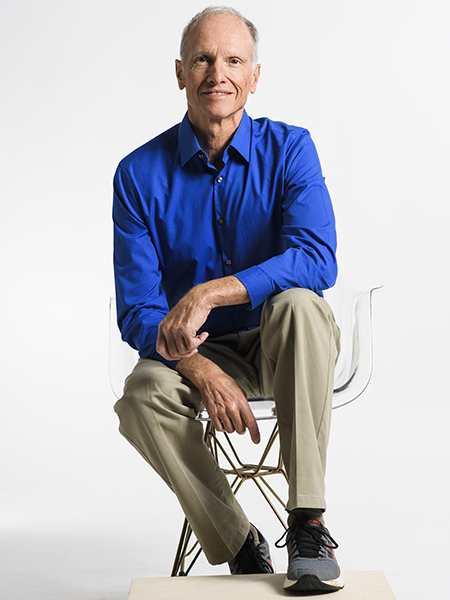
Alten “Skip” Grandt, Jr., the head of AAE at the time, was searching for a professor not only to fill John Osborne’s shoes but to spur the department’s propulsion major.
He found the answer in Stephen Heister in 1990, fresh out of the aerospace industry, whose background and qualifications ideally matched what Osborne wanted in a successor and the kind of innovative and progressive mind Grandt needed to propel the research area.
Heister embarked on a research program that was based on computational modeling of injectors, but student interest soon started tugging him into the experimental realm.
Eager AAE graduate students Eric Wernimont, Mark Ventura and Scott Meyer asked to use a test cell at the lab, signaling a shift in the future of not only the lab but the study of propulsion in the school, and, ultimately, at Purdue University.
The Thermal Sciences and Propulsion Center, renamed after Zucrow in 1998, is now widely considered one of the premier academic propulsion facilities in the world.
“Certainly there were faculty with strong research programs, but for Zucrow Labs to be recognized nationally as a center for propulsion was all facilitated by Steve,” said Meyer, who has been Zucrow Lab’s managing director since 2009.
Heister would never say that, of course. His colleagues and friends call him humble almost to a fault, never taking credit even when it’s warranted.
In fact, Heister is wary to even mention contributions he made to the rocket lab’s resurgence in the 1990s, its rapid growth and cultivation of industry and government partners in the early 2000s, its physical and capability expansion in the next decade, or to any of its reputation-building developments. When asked, Heister redirects, praising other faculty who have performed prominent work at Zucrow Labs and lauding students who have used the facility to launch careers in industry.
“We can all claim that our research is what defines us. But it’s not,” Heister said. “It’s the people that define us and the accomplishments of those people and what small impact we might have had on those people during their small time that they spend here with us. That’s the thing that certainly gives me the most pride.”
Building relationships
Erik Dambach knew an email would be coming.
It’s rare Steve Heister allows an important moment to pass without reaching out to a former student.
In fact, Dambach can’t recall a single career milestone, for his own work or an accomplishment of his companies, in which he didn’t hear from Heister.
When SpaceX’s Dragon berthed with the ISS, Heister sent a congratulatory note. When SpaceX’s Falcon 9 launched and landed, same. When Heister learned Dambach left SpaceX and returned to Blue Origin, where Dambach initially was an intern, Heister reached out to wish Dambach the best.
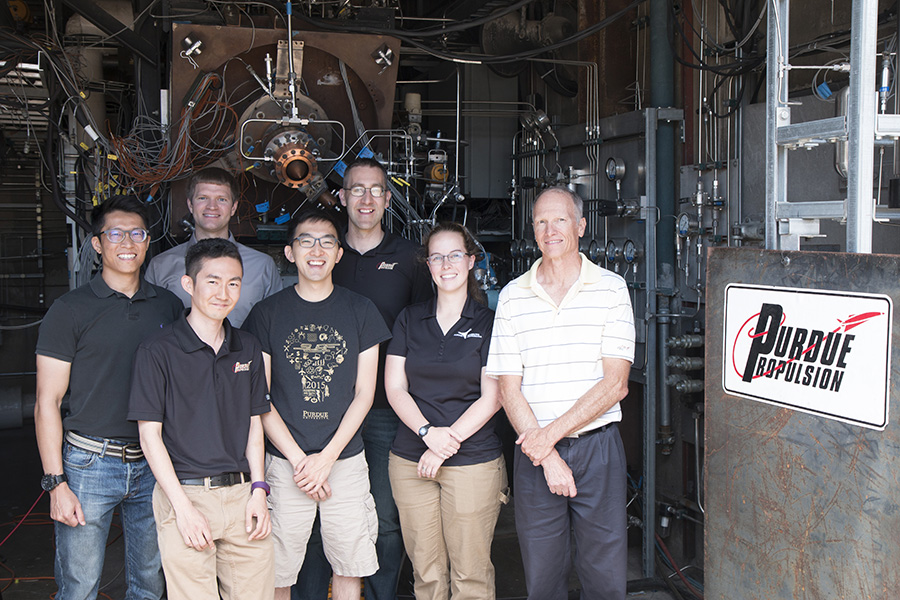
Seemingly each one of Heister’s former graduate students have their own specific examples.
And not just of the professional variety.
Heister has attended several former students’ weddings. He has offered congratulations on births. He’s rallied up large groups for drinks when he’s traveled to the “hot spots” for alumni, gathering as many as 30 alumni on multiple occasions in Southern California, and also has been intentional about making dinner plans with even just a single former student when he visits other parts of the country.
That’s what makes Heister special.
“We still talk all the time. I think about how many students he’s had that he has to keep up with and he does it,” said Steven Hunt, a senior propulsion engineer at Virgin Orbit who completed his Ph.D. work under Heister in 2016. “He actually helps us in our careers. It’s remarkable.”
When Heister says mentorship of students and the ensuing relationships that result are cherished and savored — he actually called himself “sappy” — and that those constitute the lasting impact of his faculty tenure in the School of Aeronautics and Astronautics, it’s not lip service.
He intentionally has worked at building bonds.
When Dambach (MSAAE ’07, PhD AAE ’10) wanted to perform research in a different location for a few months after completing his Ph.D. qualifying exams, Heister helped identify an opportunity at the Air Force Research Lab at Edwards Air Force Base. On another occasion, after Dambach was finishing a vacation in Israel, Heister arranged for Dambach to have a tour of the gelled propellants laboratory and meet the primary researchers at Technion-Israel Institute of Technology, with whom they were collaborating. Equally important, when Heister learned Dambach’s grandfather had only days to live, he encouraged Dambach to “drop everything and go home,” despite it interrupting a schedule-critical test campaign in Dambach’s MS research.
When Heather Wiest (MSAAE ’13, PhD AAE ’17) was interested in becoming a leader in a student group, applying for fellowships or teaching a course, Heister helped to make those opportunities happen and provided assistance when needed, she said. When she was exploring opportunities in teaching, Heister allowed her to guest lecture his courses and helped her become a primary instructor of an AAE course while she was a Ph.D. candidate.
“Steve was one of my biggest supporters, even outside of my research,” said Wiest, who typically sees Heister once or twice a year since she graduated.
The COVID-19 pandemic only amplified Heister’s thoughtfulness and care for his graduate students.
From Day 1, Heister made it clear students’ health and comfort level were top priorities, current Ph.D. student Jenna Humble said. If online advising was preferred, that happened. But, through it all, Heister made himself available and kept communication open.
“There’s a lot of back and forth,” said Humble, who started working with Heister in 2016 as a master’s student. “He definitely cares.”
Well-being of students is evident in his teaching, too.
Passion for teaching
Steve Heister, simply, enjoys teaching.
Whether it be in a classroom full of undergrads, offering graduate-level courses or in the day to day with his graduate students. He’s a five-time winner of the School’s Elmer F. Bruhn Award for teaching, via a vote of the undergraduate student body in AAE. Those are badges of honor.
Throughout his Purdue tenure, Heister has continually made changes with students in mind.
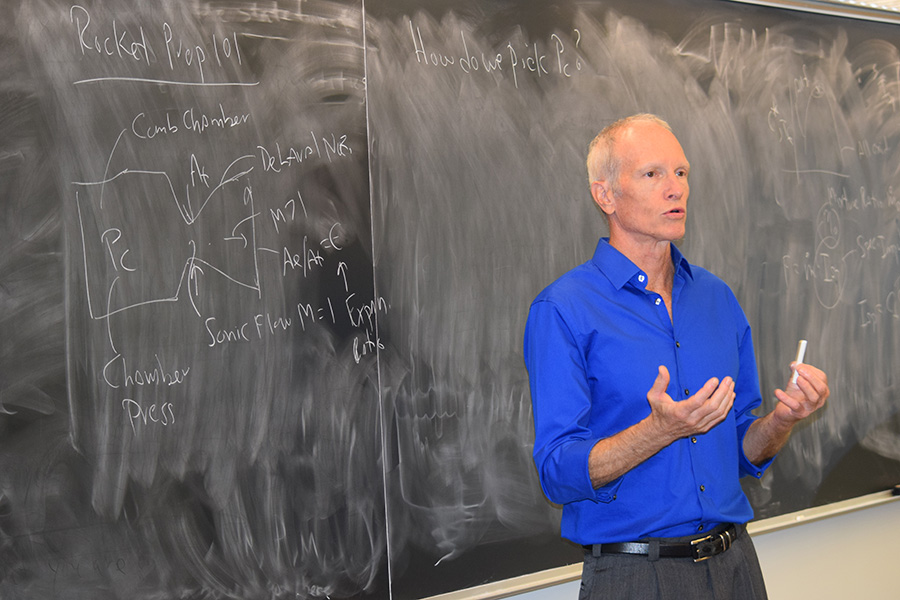
He has developed new courses and opportunities, whether it be receiving a grant to build a rocket engine test stand and to procure hardware to launch model rockets or adding a hypersonic propulsion course in 2002.
Heister was able to leverage relationships that were being fostered with Rolls-Royce to create new opportunities, and, ultimately crafted a path toward developing the nation’s first University Technology Center. The focus was on high-mach propulsion, so that was part of the motivation for the development of the hypersonic propulsion course.
“But our students also were interested,” Heister said. “There was a bit of a void. We had a course in gas turbines, kind of conventional gas turbines, but we didn’t have one that talked about ramjets and scramjets and turbo ramjets and things like the SR-71, we hadn’t really touched on. So the course grew out of those interests.”
Heister realizes the importance of staying relevant. He knows engineers want to have their hands on things and make things work. It’s why he creates new courses. It’s why his homework always pulls real-life examples, in-the-moment problems. It’s why his exams are so challenging, for students to ponder.
“There really was no way to study for his exams other than you really have to know your stuff and really have to apply it,” said alum Kevin Miller, who worked with Heister on independent study projects and courses in the early 2000s. “He’d have crazy exam questions about rockets flying through space and all of a sudden it’s hit by a rifle shot and you have a hole in the thrust chamber. What happens now? It’s just out of left field.
“You really had to think of things outside the box.”
Heister wants students to stay curious. Probably because he knows the value of such a trait.
It’s one of his finest.
Developing an aerospace engineer
Steve Heister will never forget the day.
On a sultry July evening in Michigan, a 10-year-old Heister was at his neighbor’s house, swimming in their pool. His parents called him home with a sense of urgency: Americans were getting ready to step foot on the Moon.
Heister rushed home and watched, in amazement.
It happened to be a full Moon that night, and he’d look at the TV, look up at the Moon, look back to the TV. The definition of a double-take.
He didn’t realize it at the time, but he’d later say, “That’s the day I became an aerospace engineer.”
Family
Spouse Edie Schmidt; son Tyler; grandson Anderson James
Always makes time for ...
Working out and golfing. "I hope to shoot somewhere in the 80s. Some days in the 90s. Some days in the we-won't-talk-about."
Did you know?
Currently splits time between Indiana and Florida. Edie took a job in Fort Lauderdale three years ago, so she and Steve rearranged schedules so he can spend some time with her during the spring semester, in January, February and March. "Ideally, I make a trip up once a month or so to see my students because I'm still very active with the research and we have a lot going on."
That fall when his fourth-grade teacher asked students to write a story and gave them several topics, Heister wasn’t interested in any of them. He already knew his story’s focus — and its twist.
It started with Billy and Joey watching cowboys fight Indians on TV. Then they switched the set off and headed outside. To build a rocket.
That passion continued to grow, as Heister worked his way through high school and identified a college. Because his family didn’t have a lot of money, Heister wasn’t going to be able to afford out-of-state tuition. Fortunately, one of the country’s best aerospace engineering programs was in his home state.
As soon as Heister took his first propulsion class in Ann Arbor from Professor Thomas Adamson, a 1949 Purdue aeronautical engineering graduate, he knew propulsion was “his thing.” So much so that he left the Navy ROTC program — he was on track to be a pilot — at the end of his sophomore year and started to focus on engineering.
After obtaining his bachelor’s degree in 1981, Heister took a job at Lockheed California Company in Burbank, right next to the famous Skunk Works, to work on engine installation for the L-1011 commercial transport and the Lockheed S-3, a carrier-based anti-submarine airplane.
After a year, Heister was ready to return to school. He went back to the University of Michigan and did a coursework master’s. During that time, he was a teaching assistant in the fluids lab, and his focus intensified on rockets. That led to a next-step search: He identified The Aerospace Corporation and its work in the space industry as a critical player in southern California, and it also had a good education program. By that point, Heister was entertaining the idea of obtaining a Ph.D.
He started at Aerospace in 1983, and his Ph.D. work at UCLA began about two years later.
“That was hard, actually,” Heister said. “The Challenger failure was in 1986. Shortly after the Challenger failure, the Air Force lost its biggest launch vehicle, the Titan, to the same type of malfunction. It was a solid rocket booster that, basically, blew up, shortly after ignition. So I was on a panel and we were flying all over the country, and I’m trying to take classes and prepare for qualifying exams. It was a very stressful time. But I got through all that, and I learned a lot from those failure investigations.
“We don’t want things to fail, but they are learning opportunities — especially for the younger staff like myself. I learned a lot from that, not only about solid rockets but just about managing large space programs and how top people think about things, approach things, think about risks, which I hadn’t considered those sorts of issues.”
After completing his Ph.D. work in 1988, Heister started feeling tugged to teach. To started small: Teaching a rocket propulsion “for just a handful of people” at a small college in the area. He enjoyed it enough that he started looking for academic positions.
“I was more nervous about research aspect, to be honest, but I did like teaching. I like a university setting. I enjoyed the prospects of teaching young people. I was a young person at the time,” he said with a laugh.
Purdue University provided the perfect fit.
The School of Aeronautics and Astronautics had been searching for a propulsion person for three years, since Osborne had retired. Osborne desperately wanted his replacement to be a hands-on rocket propulsion person. Heister had a background in solid rocket motors and solid propellants, which happened to be Osborne’s area of study.
“I was lucky. I think it resonated with him because of my qualifications,” Heister said. “I was just very fortunate to be given the opportunity.”
Heister always had put energy into teaching, but his research started to blossom toward the time when he was promoted to full professor in 1999.
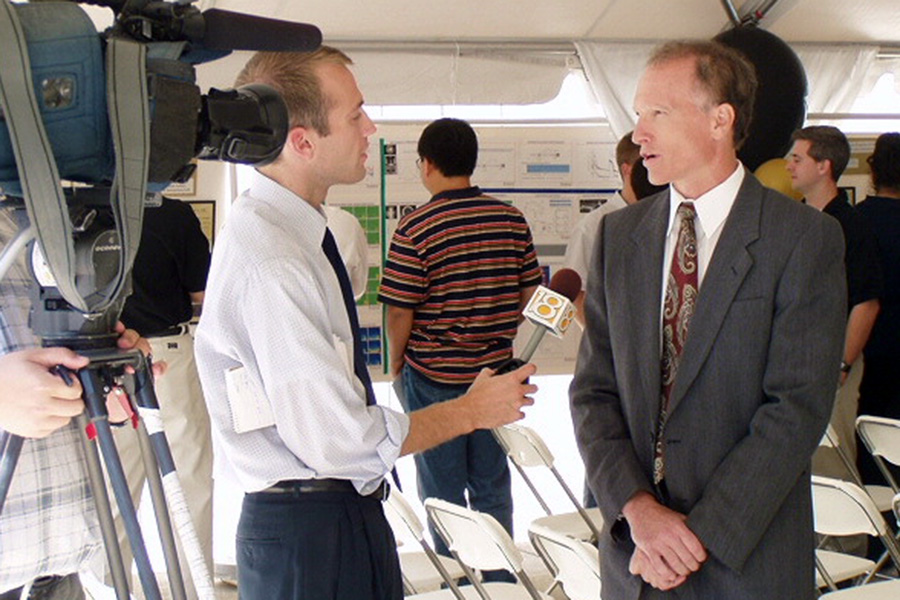
His innate curiosity didn’t allow him to stick to any one area of propulsion for long. Though he came to Purdue as a solid rocket propulsion guy, Heister's interest shifted to high-mach propulsion working with Rolls-Royce to open its first University Technology Center in the U.S. in 2003. Heister led the center for more than 15 years with numerous AAE faculty and their students participating in its projects.
Since 2014, a major focus of his research has been related to rotating detonation engines (RDEs). The RDE is a device that exploits continuous detonative combustion in a thin annular channel and has the potential to advance aerospace propulsion performance significantly.
“That’s the neat thing about being a professor, you’re able to steer things and work on things that truly interest you,” Heister said. “Especially in these new areas, RDEs, very unique dynamic injection environment. There’s no reason why the injectors should look the same as they do for a conventional engine, so that’s captivating to me. ‘OK, it’s a new clean sheet of paper. Let’s think about new ways to solve this problem.’ ”
After the problems are identified.
One of the challenges with RDEs is “there just aren’t answers yet,” Humble said. The work isn’t about rehashing old problems. Heister and his research group are dealing with new problems that no one understands and finding new problems people didn’t know existed. Unlike conventional rocket engine work that hopes to eek out .1 percent of performance, everything the group is doing is about trying something new.
That’s ideally suited for Heister.
Dambach said he thinks Heister would be bored if he stayed on the same “narrow research topic” for too long.
But this RDE research? There are so many unknowns, so much potential still for the technology, it stays fresh and exciting. Nicely aligned for someone whose specialty is as an “ideas man,” Humble said.
“Everything we’re doing right now with RDEs is driven by two things. The first is just the love of space,” Humble said. “He always tells the story about watching the Moon landing. I grew up watching the shuttle and watching all the old space movies. There’s a love of it that goes into this. But there’s also the challenge of, ‘Can I make something better? I don’t just want to make the same things, I want to make something exceptional.’ That’s what we’re doing. That’s what he is pushing us to do. Why do we keep doing the same things when we can do something extraordinary?’”
Simply, in a persistent pursuit of innovation, Heister’s curiosity continues to rule.
And it’s not surprising to people who have worked with him.
Dambach’s master’s research essentially came out of one of Heister’s “crazy” ideas. They were able to satisfy the objectives of the sponsor while also having an excuse to design, build, and test a ~1000 lbf hybrid engine, Dambach said.
“That was part of the fun of being one of his graduate students,” Dambach said.
Meyer sees it, too, in his role at Zucrow, joking Heister has tons of not-always-great ideas. But Meyer quickly follows with how enjoyable of an environment that creates, knowing Heister always will come up with different ideas and different ways to look at problems.
It’s an insatiable curiosity.
“It’s really fascinating how his brain works,” Humble said. “He manages to operate more in this space of what could be. He doesn’t have to have the end goal in mind. He dreams up what the end goal is. That’s so important, especially in research. It’s people like him who are the reason we come up with new technologies. It’s people dreaming about things we haven’t been able to do yet and say, ‘Yeah, I think we can do that.’”
That rubs off in the best way on his students.
“He’s basically going to the next cutting-edge technology,” Miller said. “I also feel like nothing he’s doing there is too far flung where it doesn’t have a chance of getting into products soon. That’s another key thing. That means that the students he’s turning out are actually probably going to realize products they’re working technology on in college.”
And they can do that, largely, because of Zucrow Labs.
Transforming Zucrow
After Heister arrived in West Lafayette, he quickly put his head down and started a research program. His Ph.D. was computational work, so he figured he’d use some of the assets he learned from his advisor, Professor Ann Karagozian, who taught him analytic techniques and modeling techniques.
Then Wernimont showed up. He’d spent nearly five years in industry after his BS from AAE before returning for his master’s.
Then Ventura, also with industry experience, showed up.
Then Meyer.
After Heister secured the test cell, work started on hybrid rockets and hydrogen peroxide propulsion.
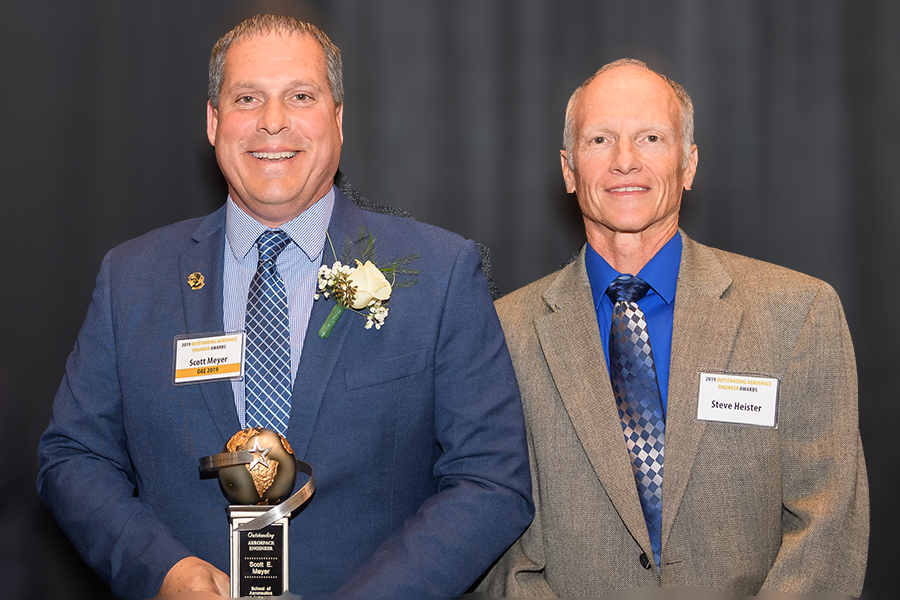
Heister, then, was learning experimental work from his students.
“I wasn’t helping with them with anything. I’m going to be completely honest,” Heister said.
But Heister recognized the passion, the same stirring that was in his belly, and he kicked in money to help the trio build a test stand to fire a rocket engine.
And he kicked into gear building the necessary connections and resources to start the Thermal Sciences and Propulsion Center’s resurgence.
In 2001, Heister and ME Professor Jay Gore teamed with Rolls Royce and received a grant from the 21st Century Research and Technology Fund, established by the State of Indiana to promote high-tech research and development and to help commercialize innovations. The grant contained about $1 million for lab renovation and research in pulse detonation and rocket propulsion.
With those funds, Heister tabbed Meyer to come back to Purdue as senior engineer at the labs. (Eight years later, Meyer moved into the managing director role. Heister considers Meyer one of the “premier maintenance and facility and development people in the nation, if not the world.”)
Later in 2001, Heister led the recruitment of Bill Anderson, who’d just been hired at NASA Marshall Space Flight Center and had spent years in industry. That hire started a chain reaction. Rather than building a new test cell, which had been the initial plan with the 21st Century funds, Anderson suggested funds should be utilized to refurbish the high-pressure lab at TSPC, “the gem, in some respects, of facilities Dr. Zucrow developed,” Heister said.
“Dr. Anderson led the development of the rocket capability there and installation of the liquid-oxygen system, which truly distinguishes Purdue amongst the universities,” Heister said. “We’re really only the university operating a high-capacity liquid-oxygen system. Anderson played a key role in developing relationships with NASA and infrastructure for all of that.”
In 2003, a second 21st Century grant provided another $1 million for air-breathing propulsion research.
Later in 2003, Purdue became the nation’s first Rolls-Royce UTC as the High Mach UTC came into existence in the summer, allowing assets to be added to the gas turbine cell.

In 2006, the UTC received a four-year, $4-million expansion, enabling Zucrow to develop more experimental capabilities. The grant was to investigate supersonic business jet propulsion. So Purdue developed a facility, put up a small building and started to really exploit the Zucrow assets in terms of the air system, Heister said.
“That taught us a lot,” Heister said. “I learned a lot about facility operation design, designing what they call a direct-connect experiment where you force air into the propulsion device. Then the rockets work was going on in parallel.”
In 2009, Timothee Pourpoint was added to AAE’s faculty, and the green propellants lab was developed. That was another very unique capability for a university to have, and Pourpoint now is regarded as “one of the global authorities” in hypergolic propellants, Heister said.
In 2011, Heister was named director of Maurice J. Zucrow Labs.
“When he became lab director, we’d pretty well done about as much as we could with our existing infrastructure,” Meyer said. “With a vision for our first new building since 1965, Steve was like, ‘We need to do something. Everyone is out of space. We need more capability.’ He wasn’t saying, ‘We should do this.’ He was saying, ‘What should we do?’ That engaged everyone to bring in ideas and requirements, and in 2012 we developed the design of what would become ZL8.”
But they needed funding. And Meyer credits Heister for the next step, “successfully making the case to the administration that this was important and that our vision was valid, and it was good.”
In early 2015, those funds were secured when $5 million of the Lilly Foundation’s largest cash donation in Purdue history was designated to Zucrow Labs to complete the fund raising for the new test cell building and High Pressure Lab renovation project.
In 2017, a year after Heister had stepped down as Zucrow Labs director, the expansion was completed, unveiling five high-pressure combustion test cells, a laser diagnostic lab, a 1,500-degree air heater, additional control rooms and new offices.
“Although a team effort, development of this world-class propulsion program is due in great part to the leadership provided by Professor Heister in recruiting and nurturing new faculty and students to the propulsion area,” Grandt said. “Clearly, hiring Steve Heister was one of the best decisions of my tenure as School Head.”
Heister reminds often, too, “an organization is the people who make it.”
Because, of course, it comes back to people for him.
Part of the legacy
People flood Steve Heister’s mind when he reminisces.
Like how when he was teaching in a large, deep-seated auditorium in Grissom Hall he could always tell the temperature outside based on Erika Pearson’s face. (It’d get really red when it was cold.)
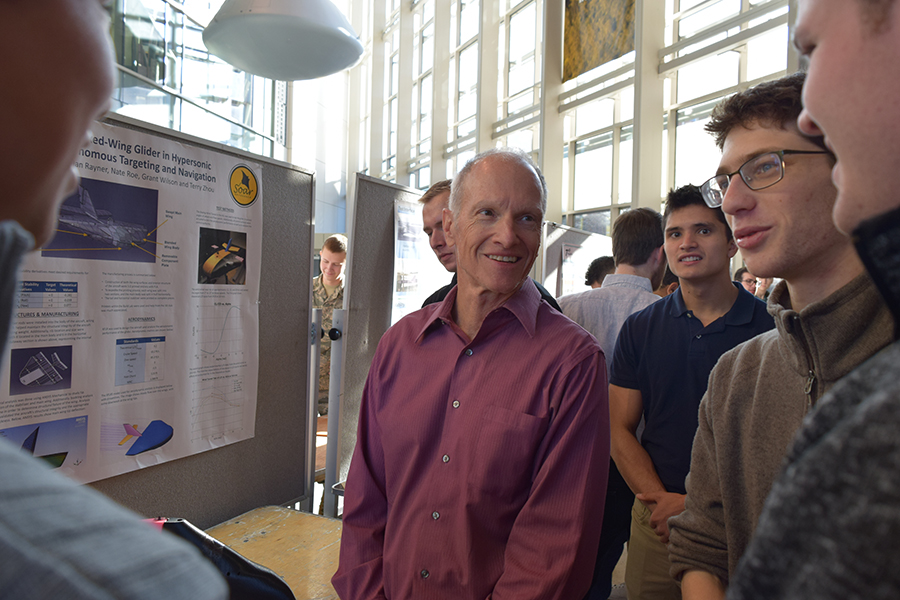
Or how it felt during his first year teaching a graduate-level rocket propulsion course in the mid-1990s when Bill Gerstenmaier walked in. Gerstenmaier, on a leave from NASA to pursue a doctorate, was several years Heister’s senior and probably could have taught that 539 class. But Gerstenmaier was kind, sometimes approach Heister after classes to politely offer feedback, saying, “You know on this problem? Did you think about …”
Or how he won’t soon forget during evening exams when Beth Stubbings (now Moses) would come up to the front, take off her shoes and put on bunny slippers.
“It was, like, one of her routines. It was just hilarious,” Heister said with a laugh. “I’m looking down at these slippers, like, ‘What the heck?’”
Heister can reel off stories endlessly. In his 31 years as a professor in AAE, he has impacted hundreds of undergrads and has been thesis advisor for more than 100 graduate students, both Ph.D. and master’s.
For every memory he has, his students counter with their own. They praise him for pouring into their lives, for helping direct the professional courses of them, for maintaining a presence.
Sometimes, he lets that soak in.
“I hope they appreciate that I provided some guidance and education. Inspired them. That’s all a teacher or a professor could want,” Heister said. “Many of them came to me. That’s one thing — I didn’t recognize the importance of going to a university with the history that Purdue had, a rich history in propulsion. It was all ripe. It’s in the water here. People show up that are incredible people. They just want to be here because of the prior history. So I certainly exploited that.
“We see that to this day. Students show up. I don’t really actively recruit students. They show up on my doorstep so excited and passionate, it’s obvious that they’re going to be a success no matter what. It’s like, ‘Yeah, I think I want to be a part of that.’ ”
I've gotten to do a very wide range of things. It's been interesting. My master's was all computational. My Ph.D. is all experimental. So working with him, I've gotten to work on a lot of different aspects of the same problem, which has been really fascinating. The work we're doing right now, what Dr. Heister has focused on since 2014, rotating detonation engines, his group has pretty much been one of the leading universities on this topic." – Current Ph.D. student Jenna Humble
If you look at most professors, they’ll have 50 publications that are more or less on the same topic. He has, like, 50 publications on 50 topics, just all over the board. He has studied everything. The amount of interest and enthusiasm he has for this stuff, it’s contagious." – AAE alumnus Steven Hunt (PhD '16)
Steve is a great colleague. He welcomes input and always looks for consensus. He is equally adept as an individual researcher. Those traits have a lot to do with his success at Purdue. " – AAE Professor William Anderson
